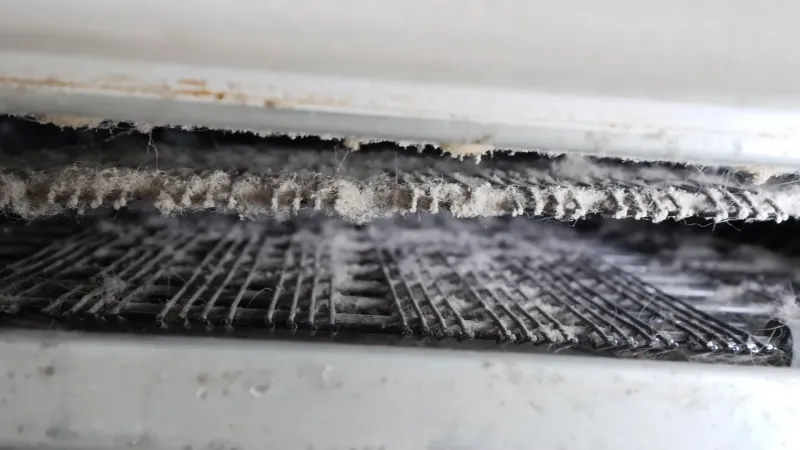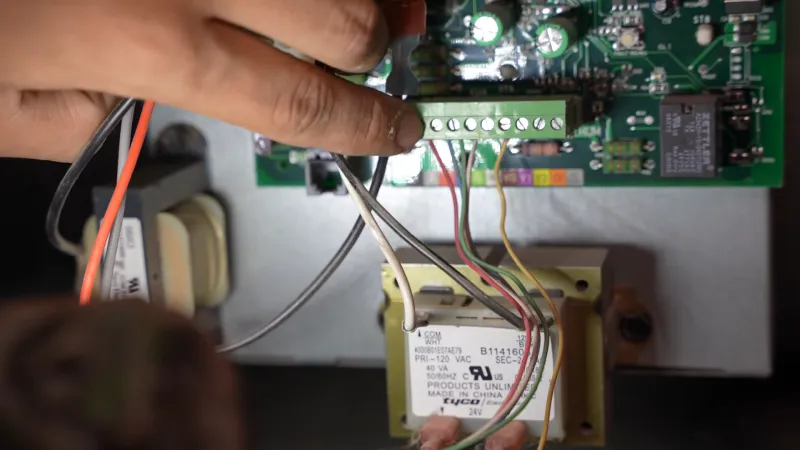GE Cafe Refrigerator Temperature Problems and Solutions
GE Cafe refrigerators are known for their sleek design and innovative features, making them a popular choice among homeowners. Maintaining the temperature of a refrigerator is crucial in keeping food fresh and safe to consume.
A refrigerator that is not functioning at the correct temperature can result in spoiled food and wasted money. This blog aims to highlight 5 to 10 common GE Cafe refrigerator temperature problems and provide effective solutions to resolve these issues.

Whether you are a DIY enthusiast or prefer to call a professional, this guide will help you get your GE Cafe refrigerator back to functioning at its optimal temperature.
You'll Learn About
GE Cafe Refrigerator Temperature Problem
GE Cafe refrigerators may experience temperature problems due to a variety of reasons, such as dirty condenser coils, understocking in the fridge compartments, low temperature (0-8°F), broken thermistor, thermostat, or temperature control board.
The standard temperature for a GE Cafe refrigerator is 37°F (2°C). However, different models may have different recommendations. It takes 24 hours for the controls to set correctly and for the fridge to start cooling.
Samsung Refrigerator Problems and Solutions
If the temperature does not stabilize even after 24 hours, it could be due to the wrong temperature setting, which is best at 37-42°F. GE Profile refrigerators come with a self-diagnostic mode, which can be used to reset the temperature by going to the self-diagnostic mode, clicking on any temperature button in the control panel, and holding the four buttons of adjustment for three seconds.
Problem 1: Dirty Condenser Coils
Condenser coils are an important component of a refrigeration system, as they help to transfer heat from the inside of the refrigerator to the outside. These coils are typically located at the back or bottom of the refrigerator and play a crucial role in maintaining the temperature inside the unit.

Why Dirty Condenser Coils Can Lead to Temperature Problems
Dirt and debris can build up on the condenser coils over time, reducing their efficiency and making it more difficult for the refrigeration system to transfer heat. This can result in the temperature inside the refrigerator being too high, causing food to spoil or even freeze. In addition, dirty condenser coils can put a strain on the compressor, potentially leading to more serious problems down the line.
How to Clean the Condenser Coils
Cleaning the condenser coils on a GE Cafe refrigerator is a simple and straightforward process. First, unplug the unit and locate the coils at the back or bottom of the refrigerator. Next, use a vacuum with a brush attachment to remove any dirt and debris that has accumulated on the coils.
If the coils are particularly dirty, you may need to use a cleaning solution specifically designed for condenser coils. After cleaning the coils, be sure to allow the unit to sit for at least 15 minutes before plugging it back in to allow the coils to dry completely.
Maintaining clean condenser coils is an important part of ensuring that your GE Cafe refrigerator operates efficiently and effectively, and can help prevent temperature problems from occurring in the future.
Hot Weather Refrigerator Problems and Solutions
Problem 2: Understocking
Understocking refers to a situation where the amount of food and beverages stored in the refrigerator is not sufficient to fill the entire interior space. This leads to more air circulating inside the fridge, affecting its temperature.
How Understocking Can Affect the Temperature
Understocking can affect the temperature inside the refrigerator as the empty spaces within the fridge create cold air pockets. When the door is opened and closed, these pockets of air can mix with the warm air, leading to temperature fluctuations. Additionally, the refrigeration system has to work harder to maintain the desired temperature, which can lead to an increase in energy consumption and higher electricity bills.
How to Resolve Understocking Issues
To resolve understocking issues, it is recommended to keep the fridge well-stocked, especially when it’s not in use. This helps keep the temperature consistent and reduces the workload on the refrigeration system.
If you have a large fridge and don’t need to store a lot of food, consider keeping containers filled with water to maintain a consistent temperature. Another solution is to use shelving spacers to reduce the amount of empty space in the refrigerator.
Understocking can significantly affect the temperature inside the GE Cafe refrigerator. To avoid this issue, it is essential to keep the fridge well-stocked, and if necessary, use containers or spacers to reduce the amount of empty space. By doing this, you can maintain a consistent temperature, reduce energy consumption, and avoid temperature fluctuations.
Problem 3: Low Temperature
GE Cafe refrigerators are designed to maintain a temperature between 33°F and 41°F in the refrigerator compartment and 0°F in the freezer compartment. This temperature range is ideal for preserving food and keeping it safe for consumption.

How Low Temperature Can Lead to Problems
When the temperature of the refrigerator is too low, it can lead to a number of problems. For one, it can cause food to freeze, which not only affects the quality and taste of the food but can also cause it to spoil more quickly. Additionally, low temperatures can increase the risk of bacterial growth, making food unsafe to eat.
How to Adjust the Temperature
If your GE Cafe refrigerator is experiencing low temperatures, you can adjust it using the controls on the interior of the fridge. Most GE Cafe models have a control panel that allows you to adjust the temperature by pressing a button or turning a dial.
If you’re having trouble adjusting the temperature, refer to the user manual for your specific model for more information. If the temperature control is still not working properly, it may be necessary to have a technician diagnose and repair the issue.
Problem 4: Broken Thermistor
A thermistor is a small, temperature-sensitive resistor that helps regulate the temperature inside a refrigerator. It works by measuring the temperature inside the refrigerator and sending a signal to the control board, which then adjusts the cooling system accordingly.
How a Broken Thermistor Can Cause Temperature Problems
If a thermistor fails, it can no longer accurately measure the temperature inside the refrigerator, leading to temperature fluctuations. The control board may not receive the correct information about the temperature, causing the cooling system to either turn off when it shouldn’t or run continuously.
How to Resolve the Issue of a Broken Thermistor
To resolve the issue of a broken thermistor, it is important to replace it with a new one. This is a relatively simple repair that can be done by a qualified repair technician or, in some cases, by the homeowner. It is important to follow the manufacturer’s instructions when replacing a thermistor to ensure that it is installed correctly and to avoid damaging the refrigerator.
a broken thermistor can cause significant temperature problems in a GE Cafe refrigerator. If you experience fluctuations in temperature, it may be time to have your thermistor checked and replaced. By doing so, you can ensure that your refrigerator is working correctly and preserving your food at the proper temperature.
GE Dual Evaporator Refrigerator Problems and Solutions
Problem 5: Broken Thermostat
The thermostat in a GE Cafe refrigerator is a device that controls the temperature inside the fridge. It monitors the temperature and communicates with the compressor and fan to regulate the cooling process.
How a Broken Thermostat Can Lead to Temperature Problems
A broken thermostat can result in a number of temperature problems, including temperature fluctuations, warm air getting inside the fridge, and the fridge not cooling properly. If the thermostat is not functioning correctly, it will not be able to properly regulate the cooling process, leading to the above-mentioned issues.
How to Resolve the Issue of a Broken Thermostat
If you suspect that your GE Cafe refrigerator’s thermostat is broken, you should immediately unplug the fridge and call a professional for repair. Do not attempt to repair the thermostat yourself, as it can be dangerous and can potentially cause further damage to the fridge. A professional will be able to diagnose the problem and either repair or replace the thermostat as necessary.
A broken thermostat is a serious issue that can negatively impact the temperature inside your GE Cafe refrigerator. If you experience any temperature problems, it’s important to take the necessary steps to resolve them, whether that’s cleaning the condenser coils, stocking the fridge properly, adjusting the temperature, or calling a professional for repair. By taking the time to address these issues, you can help keep your fridge functioning properly and preserve the quality of your food.
Problem 6: Broken Temperature Control Board
A temperature control board is a vital component of a refrigerator that regulates its temperature by controlling the cooling system. It monitors the temperature inside the refrigerator and turns on or off the cooling system based on the readings.
How a Broken Temperature Control Board Can Cause Temperature Problems
A broken temperature control board can cause the refrigerator to run continuously, leading to a drop in temperature and affecting the food stored inside. In some cases, the board may not function at all, causing the refrigerator to stop working altogether.

How to Resolve the Issue of a Broken Temperature Control Board
To resolve the issue of a broken temperature control board, it is recommended to call a professional repair service. The repair service will diagnose the issue and replace the faulty board if necessary. Replacing a temperature control board is a complicated task that requires technical expertise and should not be attempted by an untrained individual.
a broken temperature control board can cause serious temperature problems in your GE Cafe refrigerator. If you suspect that the board is faulty, it is recommended to call a professional repair service to diagnose and resolve the issue. By doing so, you can ensure that your refrigerator continues to function optimally and keep your food fresh.
Problem 7: Lack of Clearance
The GE Cafe refrigerators need enough clearance to work properly. Clearance means the space around the refrigerator which should be free from any obstruction.
The minimum requirement of clearance is 2 inches at the top, 2 inches at the sides, and 4 inches at the back of the refrigerator. This clearance is necessary for proper air circulation, which is crucial to maintain the temperature inside the refrigerator
How Lack of Clearance Can Lead to Temperature Problems
If the GE Cafe refrigerator does not have the required clearance, then the air circulation will be restricted. This leads to reduced cooling and can result in temperature problems. As the air cannot circulate properly, the compressor will have to work harder to maintain the temperature, which can cause the compressor to overheat and eventually lead to a breakdown.
Ice Maker Problems in French Door Refrigerators and Solutions
How to Resolve the Issue of Lack of Clearance
To resolve the issue of lack of clearance, you need to ensure that there is enough space around the refrigerator. If the refrigerator is too close to the wall, then you can move it to another location.
Additionally, if there are any objects blocking the air circulation, you can remove them. By maintaining the minimum clearance, you can avoid temperature problems and keep the GE Cafe refrigerator working efficiently.
lack of clearance is a common problem that can cause temperature problems in GE Cafe refrigerators. By ensuring the required clearance, you can avoid temperature issues and extend the life of your refrigerator. If you are unable to resolve the issue yourself, you should call a professional for assistance.
Problem 8: Wrong Temperature
Maintaining the right temperature in your GE Cafe refrigerator is essential to preserve the freshness of your food and prevent spoilage.
The ideal temperature range for a refrigerator is between 33°F and 40°F, with 37°F being the sweet spot. This temperature range is cold enough to slow down bacteria growth, yet not too cold to damage your food.

How Wrong Temperature Can Lead to Problems
If the temperature in your GE Cafe refrigerator is not set to the ideal range, it can lead to a number of problems. If it’s too cold, your food may freeze and become inedible. If it’s too warm, bacteria can grow quickly, leading to spoilage and even food poisoning.
How to Adjust the Temperature
To adjust the temperature of your GE Cafe refrigerator, simply locate the temperature control dial or digital display and set it to the desired temperature. It may take a few hours for the temperature to stabilize, so be patient and check back periodically. If the temperature still doesn’t seem right, it’s possible that there’s a deeper issue such as a broken thermostat or control board, and you should seek professional assistance.
if you experience any temperature-related issues with your GE Cafe refrigerator, the solution may be as simple as adjusting the temperature. However, if the issue persists, it’s possible that there’s a deeper problem that requires professional attention. By understanding the common temperature problems and their solutions, you can keep your GE Cafe refrigerator in top shape and keep your food fresh.
Problem 9: Ge Profile Refrigerator Self-diagnostic Mode
The GE Profile Refrigerator comes equipped with a self-diagnostic mode which helps in identifying and resolving various problems with the appliance. The mode is activated by pressing a certain set of buttons in a specific sequence, which triggers the diagnostic process.
How to Reset the Temperature Using the Self-diagnostic Mode
If you are facing temperature issues with your GE Profile Refrigerator, you can try resetting it using the self-diagnostic mode. To do so, follow these steps:
- Turn off the refrigerator.
- Unplug the refrigerator from the electrical outlet.
- Wait for 5 minutes.
- Plug the refrigerator back into the electrical outlet.
- Press and hold the “Freezer” and “Refrigerator” buttons simultaneously for 5 seconds.
- Release both buttons.
- The diagnostic process will begin, and the temperature display will flash to indicate that it’s in self-diagnostic mode.
- Press the “Freezer” and “Refrigerator” buttons again to reset the temperature to the default setting.
By resetting the temperature using the self-diagnostic mode, you can resolve minor temperature problems that might be causing the appliance to behave abnormally.
GE Profile Refrigerators are equipped with a self-diagnostic mode to help users identify and resolve various problems, including temperature issues. By following the steps mentioned above, you can easily reset the temperature and get your refrigerator back to its normal functioning state.
Frigidaire Professional French Door Refrigerator Ice Maker Problems and Solutions
Conclusion
Temperature issues in GE Cafe refrigerators are a common problem that can lead to food spoilage, reduced efficiency, and even costly repairs. From dirty condenser coils to wrong temperature settings, it is important to address these problems promptly to maintain the longevity and performance of your refrigerator.
This blog has highlighted the top 9 common temperature problems and provided practical solutions for each issue. We hope this guide has been helpful in resolving any temperature issues you may be experiencing with your GE Cafe refrigerator.
Remember, regular maintenance and proper usage can prevent many of these problems from occurring. It is always recommended to consult the manufacturer’s manual or seek professional assistance if you are unable to resolve the issue on your own.




